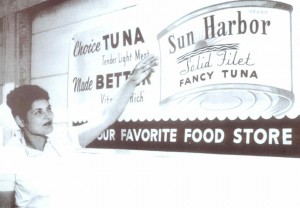San Diego pays tribute to cannery workers
When Francisco Urtasun holds a can of tuna in his hands, it takes him back to his childhood, growing up as the son of cannery workers.
As he reflected back to those early years he said he is really grateful for all the work he knows went into putting that tuna into that small can.
“Seeing my parents come back home after a long day at the canneries, made me really value what I have, and to be grateful for what I have,” said Urtasun, who works as the executive director of the Sempra Energy Foundation and director of corporate community partnerships for Sempra Energy.
Urtasun is the son of two of the thousands and thousands of people who worked in the tuna cannery industry that helped San Diego developed into a major city in the 20th century. Urtasun’s father was from the Basque Country in Spain, and his mother was from Jalisco, both barely with an elementary school level education.
The Urtasuns settled in Imperial Beach in the 1950s, and everyday the couple went to work to the canneries near Barrio Logan. Thanks to their jobs, they were able to provide their children with an education, and a stable home.
“My family’s success story is an American story, similar to that of other immigrants,” Urtasun said. “It was a home full of happiness.”
He said he still remembers the smell of fish when his parents would come home from work.
“Once I smelled that, I knew they were home,” he said, smiling. “Today I relate that smell to my childhood. It brings back good memories.”
Urtasun was instrumental in the creation of a new cannery workers tribute opening on Saturday, September 26, at Parque del Sol, a small park near the old cannery buildings where workers would go to have lunch or just have a cigarette during their breaks.
The inauguration ceremony will be held at 10:30 a.m. that day, on Cesar Chavez Parkway and Crosby Avenue, in Barrio Logan. Present will be Urtasun and former cannery workers and their families.
The artwork includes renditions of cannery workers, steel tuna, a sun made of mosaic around a coral tree, and several plaques that include the history of the tuna cannery industry in San Diego.
 “This tribute to all those workers and that important era in San Diego history has been long overdue,” said Allan Tait, project manager at the Public Art Department of the Port of San Diego, the agency in charge of the tribute. “We’re extremely excited. The tuna industry is such an important part of San Diego history that has to be acknowledged.”
“This tribute to all those workers and that important era in San Diego history has been long overdue,” said Allan Tait, project manager at the Public Art Department of the Port of San Diego, the agency in charge of the tribute. “We’re extremely excited. The tuna industry is such an important part of San Diego history that has to be acknowledged.”
The artwork was created by a group of artists from Nature Works Inc., which includes artists Valerie Salatino, Nancy and Sheela Moran.
To create the different parts of the art tribute, Salatino said the artists interviewed many cannery workers to learn more about daily life at the canneries.
“The tuna industry built many neighborhoods in San Diego,” Salatino said. “We tried to reflect and capture that era.”
The four plaques located throughout the tribute tell the story of the tuna cannery industry here.
In the early 20th century, “The tuna industry brought many jobs to the region. Portuguese, Italian, Mexican, Japanese and men of other nationalities with little more than the shirts on their backs could make a hard, but decent living as crew members or boat owners. Their wives, mothers, sisters and brothers could also make ends meet by working in San Diego’s tuna processing canneries.
“The canneries did everything: process tuna, hand-solder cans, label, market and distribute. San Diego’s tuna fishing and cannery industries helped neighborhoods such as Little Italy, Barrio Logan and Point Loma thrive for almost eighty years.
“At the canneries, frozen fish was delivered, thawed, washed, dressed, separated and cleaned. Fish were then placed in wire mesh baskets, loaded onto racks, rolled into tunnels and steam cooked. At the cleaning tables, workers removed fish heads, fins and tails. Dark and light meat was separated and 90 percent of a fish was used. Fish parts deemed not fit for human consumption went to plants that processed animal feed.
 “A cannery worker was usually paid by the piece. A typical day could last from 12 to 14 hours. In the 1920s for instance, a woman could earn about $10 a day depending on how many pieces of fish she cleaned.
“A cannery worker was usually paid by the piece. A typical day could last from 12 to 14 hours. In the 1920s for instance, a woman could earn about $10 a day depending on how many pieces of fish she cleaned.
“In the 1980’s however, San Diego’s tuna fishing industry began to move to other areas due to foreign competition, high expenses and other factors. In 1983 Bumble Bee Seafoods was the last San Diego cannery to shut its doors.”
For Urtasun, this art tribute will be a permanent symbol of the legacy and impact the tuna industry had on San Diego –and on his family.
“I’m always going to be feel proud to be the son of cannery workers,” he said.
For more information on the Cannery Workers Tribute ceremony on September 26, call the Port of San Diego, Public Art Department at (619) 686-7246 o visit www.portofsandiego.org/public-art.





